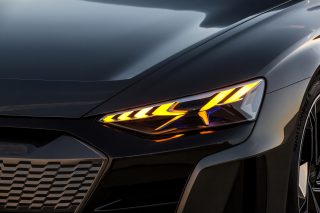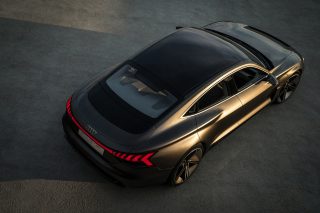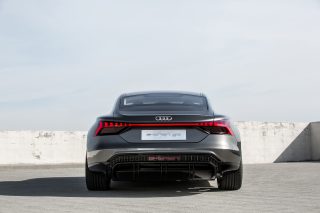#Audi #etron #GT #concept
For english copy please scroll down.
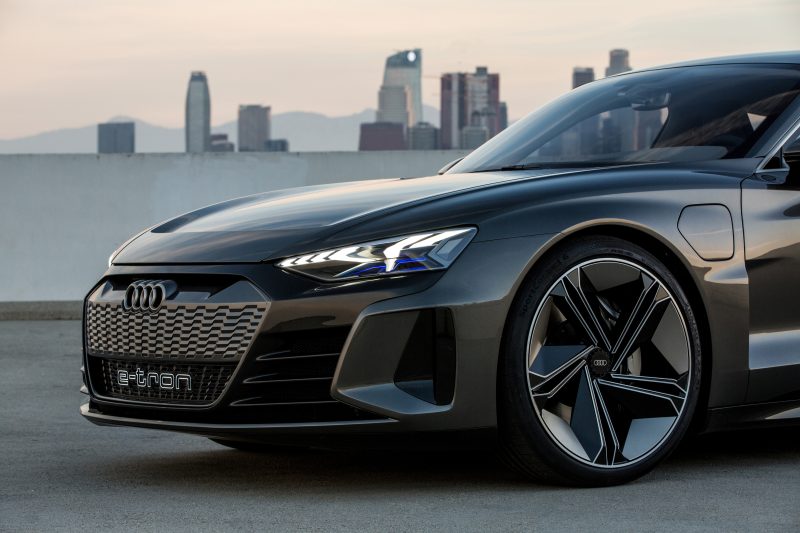
Detail
Audi e-tron, die dritte: In der Filmmetropole Los Angeles präsentiert die Marke mit den Vier Ringen einen der Stars der Motorshow 2018. Mit dem elektrisch angetriebenen Audi e-tron GT concept gibt ein viertüriges Coupé sein Debüt als Showcar. In rund zwei Jahren wird das Serienpendant folgen.
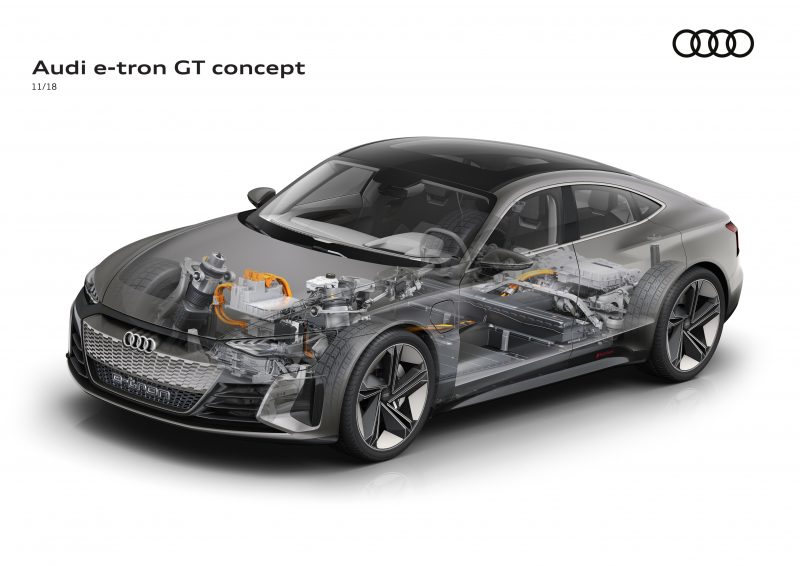
Audi e-tron GT concept
Inspiration aus dem Windkanal: Design und Karosserie
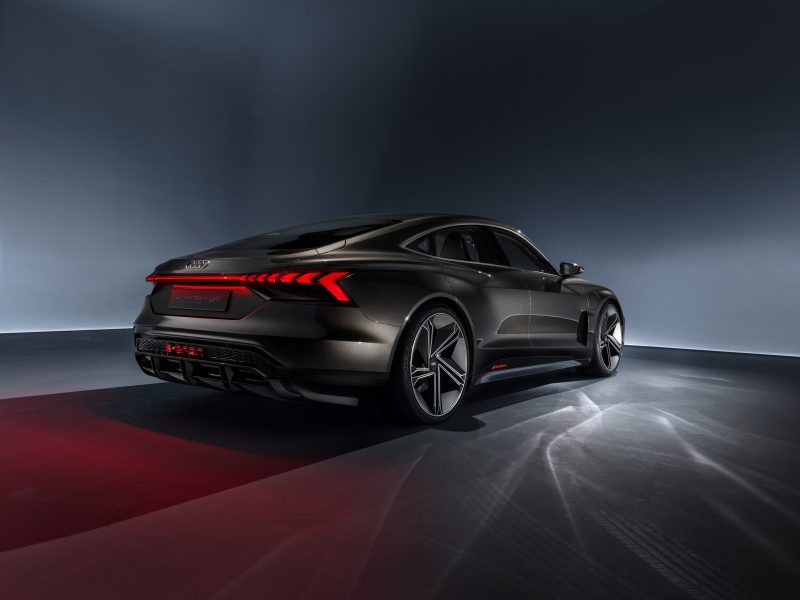
Static Photo
Colour: kinetic dust
Die weit nach hinten gezogene, flach abfallende Dachlinie des e-tron GT concept nimmt Anleihen beim markentypischen Sportback-Layout. Dies wird jedoch klar in die Zukunft fortentwickelt und weist den Weg in die nächste Evolutionsstufe der Audi-Formensprache. Gegenüber aktuellen Audi-Modellen fällt die nach hinten stark eingezogene Kabine auf. Radläufe und Schulter sind betont modelliert, unterstreichen zusammen mit dem für ein Elektrofahrzeug ungewöhnlich flachen Boden schon optisch den niedrigen Schwerpunkt und das dynamische Potenzial des Audi e-tron GT concept.
Die weiten Linien sowie die zahlreichen funktionalen Elemente der Karosserie wie die Luftauslässe der Radhäuser und der massige Heckdiffusor betonen ihren Ursprung im Windkanal. Ein niedriger und damit den Verbrauch senkender cW-Wert sowie der niedrige Auftrieb prägen sichtbar die Formgestaltung.
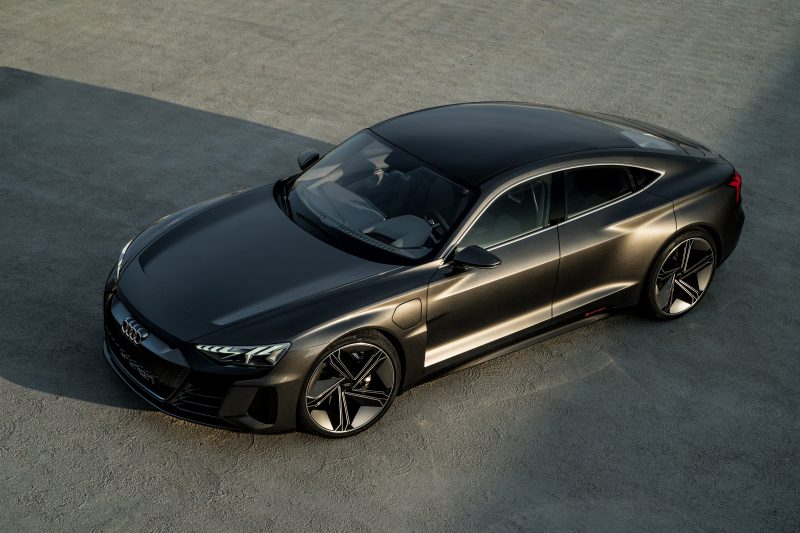
Static Photo
Colour: kinetic dust
Der Schwellerbereich zwischen den Radhäusern ist weit nach außen gezogen und klar gegenüber der Kabine abgesetzt. Er weist auf den Unterbodenbereich hin, wo sich die Batterie und damit das Energiezentrum des Audi e-tron GT concept befindet. Auch die Gestaltung der Räder mit jeweils fünf Doppelspeichen folgt sichtbar der Funktion. Ihr dynamisches Design ermöglicht die optimale Belüftung der Bremsscheiben und reduziert zugleich den Luftwiderstand. Bereift im Format 285/30, setzen die 22 Zoll großen Räder auch klare Akzente in der Seitenansicht.

Static Photo
Colour: kinetic dust
Im Zentrum der Frontpartie findet sich der markentypische Singleframe. Seine Architektur fällt gegenüber den beiden e-tron SUV deutlich horizontaler aus. Die obere Hälfte nimmt eine in Wagenfarbe lackierte Abdeckung auf. Ihre Oberflächenstruktur erinnert an das typische Wabenmuster des Grills von Audi RS-Modellen – ein visuelles Signal, das den Audi e-tron GT concept als künftiges Produkt der Audi Sport GmbH kennzeichnet.
Große Lufteinlässe in der Front verhelfen mit der gezielten Durchströmung der Karosserie zu einer wirkungsvollen Kühlung von Aggregaten, Batterie und Bremsen. Die an der Oberfläche durchströmte Fronthaube nimmt Anleihen bei den beiden jüngsten Showcars der Marke, dem Aicon und dem PB18 e-tron. Sie ist so gestaltet, dass der Luftstrom anliegt und damit unerwünschte Verwirbelungen geringer ausfallen.
Die Pfeilung der Frontpartie betont auch die Matrix LED-Scheinwerfer mit Laser-Fernlicht und unterstreicht die dynamische Präsenz des Audi e-tron GT concept selbst im Stand. Wie schon bei den aktuellen Visions-Fahrzeugen der Marke ist auch hier das Licht animiert und begrüßt den Fahrer mit einer kurzen Funktionssequenz, der horizontal sich ausbreitenden Lichtwelle: eine neue visuelle Signatur, die künftig ihren Weg in die Serie finden soll.
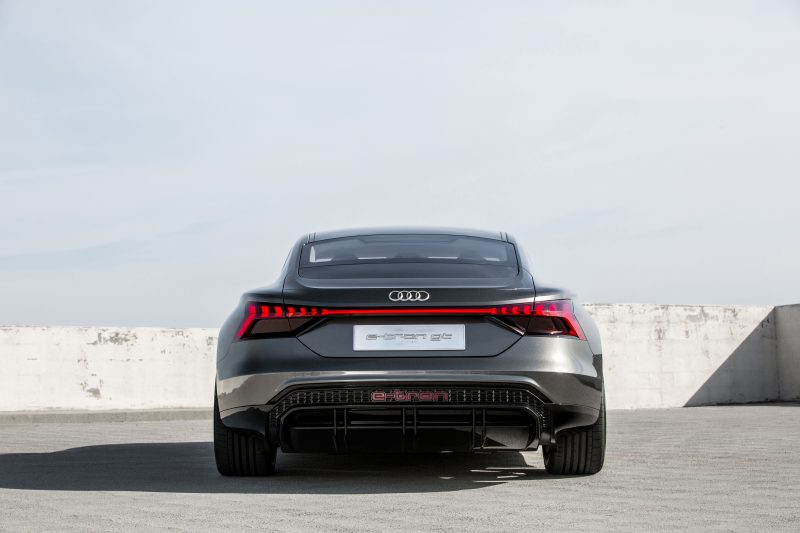
Static Photo
Colour: kinetic dust
Über die gesamte Breite des Hecks verläuft ein Leuchtenband, das sich an den Außenkanten, in den eigentlichen Leuchteinheiten, in einzelne keilförmige LED-Segmente auflöst. Diese Architektur verbindet den e-tron GT mit dem Serien-SUV e-tron und macht beide auch im Dunkeln als E-Automobile von Audi kenntlich.
Funktional und dennoch nicht technoid unterkühlt: so wirkt die neue Außenfarbe Kinetic Dust – ein warmer, dunkler Titan-verwandter Ton. Er ermöglicht, je nach Lichteinfall und -bewegung, signifikante Kontraste zwischen den Flächen der Karosserie. Matte, ebenfalls warm getönte Aluminiumelemente an Fensterschächten und Felgen verstärken diese Effekte noch.
Nachhaltige Moderne: das Interieur
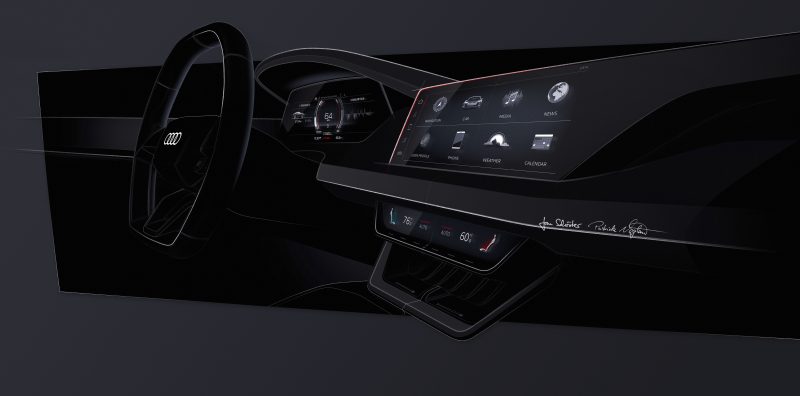
Design Sketch
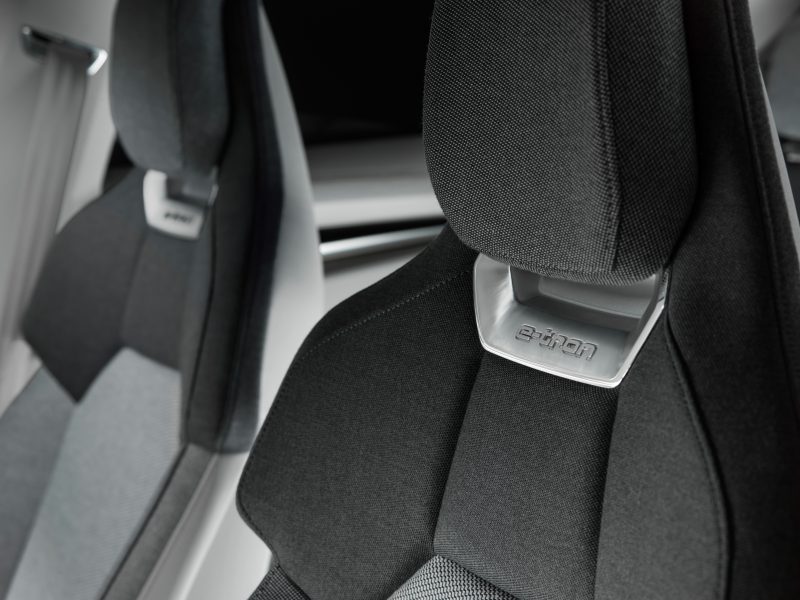
Detail
Vier Türen, vier Sitzplätze bei 2,90 Meter Radstand – im Innenraum bietet der Audi e-tron GT concept ein hohes Maß an Alltagstauglichkeit, gepaart mit höchster Qualitätsanmutung. Das funktionale Zentrum des Interieurs befindet sich vorne links, sichtbar auf den Fahrerplatz fokussiert. Die Mittelkonsole, der großflächige Touchscreen im oberen Bereich sowie die Linienführung von Türbrüstung und Cockpit rahmen den Arbeitsplatz des Fahrers, binden ihn ergonomisch perfekt in die Bedienlemente und das Infotainment des Audi e-tron GT ein. Die Mittelkonsole und das frei stehende Kombiinstrument scheinen zu schweben. Helle Farbtöne im oberen Bereich des Cockpits und die schrittweise dunklere Abstufung bis in den Bodenbereich erzeugen den Eindruck von lichter Weite. Vom Rennsport inspirierte Sportsitze in beiden Sitzreihen sorgen für besten Seitenhalt auch bei zügiger Kurvenfahrt.
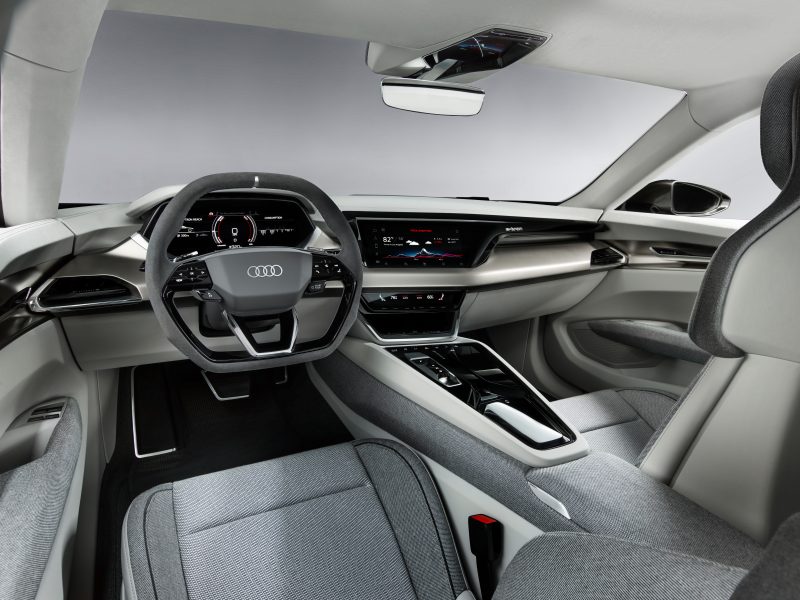
Interior Sowohl der Bildschirm des Zentralinstruments als auch der Touchscreen oberhalb der Mittelkonsole sind in Black Panel Optik ausgeführt. Sie unterstreichen die großflächige, ruhige Gestaltung des Innenraums mit seiner vorwiegend horizontalen Grundarchitektur. In Funktion lassen sich die Monitore je nach Wunsch des Fahrers in verschiedenen Layouts belegen: für virtuelle Rundinstrumente, übersichtliche Navigationskarten mit Informationen zur Reichweite oder für die diversen Funktionsmenüs des Infotainments. Die Steuerung erfolgt über den Touchscreen mit haptischem Feedback.
Die Designer haben sich beim Concept Car bewusst für den konsequenten Einsatz nachhaltiger Materialien entschieden – ein klares Statement für die automobile Moderne. Auf den Einsatz von Produkten tierischen Ursprungs verzichten sie völlig: der Audi e-tron GT concept besitzt einen veganen Innenraum. Bei den Sitzen und weiteren Verkleidungsflächen kommt ein hochwertiges synthetisches Leder zum Einsatz. Auf den Sitzflächen sowie den Armauflagen und an der Mittelkonsole finden sich textile Bespannungen, die aus recycelten Fasern hergestellt sind. Microfasermaterial kommt am Dachhimmel und den Verkleidungen der Fenstersäulen zum Einsatz. Sogar der hochflorige Bodenteppich ist aus nachhaltigem Econylgarn gefertigt, einer Recyclingfaser, die aus gebrauchten Fischernetzen hergestellt wird.

Interior
Mit gleich zwei Gepäckräumen schöpft der Audi e-tron GT concept für einen Gran Turismo aus dem Vollen. Hier macht er sich seinen Konzeptvorteil als E-Automobil mit kompakten Antriebseinheiten zunutze. Im Heck mit der großen Ladeklappe lassen sich 450 Liter Volumen unterbringen. Unter der Fronthaube gibt es noch einmal 100 Liter zusätzliche Kapazität.
Performance und Reichweite: der Antrieb
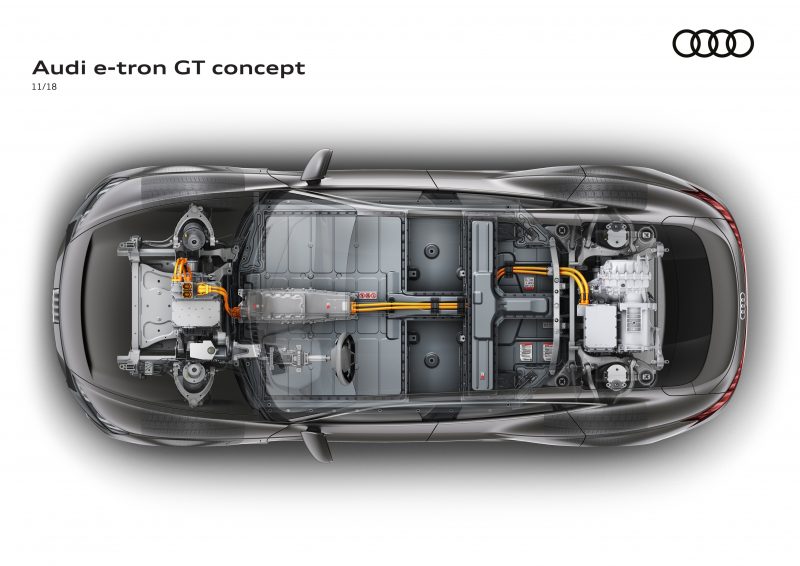
Audi e-tron GT concept
434 Kilowatt (590 PS) Systemleistung – das ist ein beeindruckender Wert für das Potential des rein elektrischen Antriebs. Je eine E-Maschine arbeitet an der Vorder- und Hinterachse. In beiden Fällen handelt es sich um permanent erregte Synchronmotoren. Sie bringen das Drehmoment über alle vier angetriebenen Räder auf die Straße – selbstverständlich ist auch der neueAudi e-tron GT concept ein echter quattro. Ein E-quattro genaugenommen, denn es gibt keine mechanische Verbindung zwischen Vorder- und Hinterachse. Die elektronische Systemsteuerung koordiniert den Antrieb zwischen den Achsen sowie zwischen linken und rechten Rädern. Das bedeutet: optimale Traktion und nur das erwünschte Maß an Schlupf.
So soll künftig eine Beschleunigung in rund 3,5 Sekunden von 0 auf 100 km/h und in kaum mehr als 12 Sekunden auf 200 km/h möglich sein. Die Höchstgeschwindigkeit wird bei 240 km/h zugunsten der Reichweite abgeregelt. Keine Selbstverständlichkeit im Wettbewerb ist die Möglichkeit, auch mehrmals nacheinander das Sprintvermögen des Antriebs voll auszukosten. Während andernorts der Antrieb aus thermischen Gründen in den Schongang zurückschaltet, kann der Audi e-tron GT concept dank seiner ausgeklügelten Kühlstrategie dem Fahrer das volle Potential der beiden Motoren und der Batterie zur Verfügung stellen.
Die Reichweite des Konzeptfahrzeugs wird, nach dem neuen WLTP-Standard ermittelt, mehr als 400 Kilometer betragen. Die Antriebsenergie dafür stellt eine Lithium-Ionen-Batterie mit einem Energieinhalt von mehr als 90 kWh bereit, die flach bauend den gesamten Unterbodenbereich zwischen Vorder- und Hinterachse einnimmt. Entscheidender Vorteil dieser Bauweise ist der extrem niedrige Schwerpunkt des Autos – vergleichbar mit dem des Audi R8 – von dem wiederum die Fahrdynamik entscheidend profitiert. Eine Allradlenkung setzt diese um in eine perfekte Synthese aus Sportwagen-gemäßer Agilität und Präzision, ergänzt um höchste Richtungsstabilität.
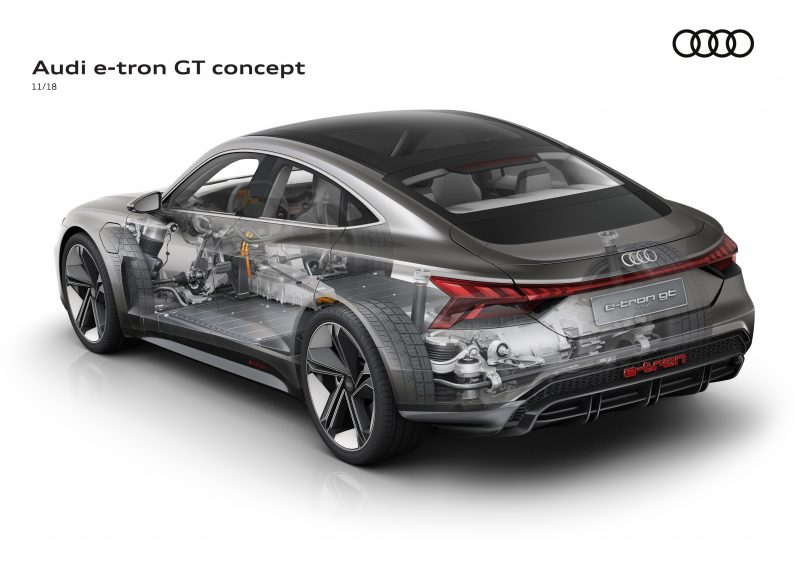
Audi e-tron GT concept
Das Rekuperationssystem trägt bei Audi E-Mobilen bis zu 30 Prozent zur Reichweite bei – auch bei einem so sportlichen Fahrzeug wie dem Audi e-tron GT concept ist dies essentiell. Die Rekuperation bezieht sowohl die beiden E-Maschinen als auch das elektrohydraulisch integrierte Bremsregelsystem mit ein. Dabei werden verschiedene Rekuperationsarten kombiniert: die manuelle Schubrekuperation per Schaltwippen, die automatische Schubrekuperation über den prädiktiven Effizienzassistenten und die Bremsrekuperation mit fließendem Übergang zwischen elektrischem und hydraulischem Verzögern. Bis 0,3 g rekuperiert der Audi e-tron GT concept ohne Einsatz der konventionellen Bremse ausschließlich über die E-Maschinen – dies ist bei mehr als 90 Prozent aller Verzögerungen der Fall. Damit werden praktisch alle normalen Bremsmanöver energetisch in die Batterie zurückgespeist. Erst wenn der Fahrer mit dem Bremspedal stärker als 0,3 g verzögert, kommen die Radbremsen ins Spiel. Beim Audi e-tron GT concept gibt es leistungsfähige Keramikscheiben, die auch bei mehrfachen extremen Verzögerungen ohne Nachlassen der Bremsleistung operieren.
Reduktion der Ladezeiten: 800-Volt-Ladesystem
Der Akku des Audi e-tron GT concept lässt sich auf mehrere Arten laden: zum einen per Kabel, das hinter der Klappe im linken vorderen Kotflügel angeschlossen wird, zum anderen kontaktlos per Induktion, mittels des sogenannten Audi Wireless Charging. Hier wird eine Ladeplatte mit integrierter Spule fest in den Parkplatz des Autos integriert, und an das Stromnetz angeschlossen. Das magnetische Wechselfeld induziert über den Luftspalt hinweg eine Wechselspannung in der Sekundärspule, die im Boden des Automobils montiert ist. Mit einer Ladeleistung von 11 kW lässt sich der Audi e-tronGT concept bequem über Nacht voll laden.
Wesentlich schneller erfolgt das Laden per Kabel, denn das viertürige Coupé ist mit einem 800-Volt-System ausgestattet. Dieses führt zur deutlichen Reduktion der Ladezeiten gegenüber konventionellen, heute üblichen Systemen. So reichen etwa 20 Minuten, um die Batterie wieder auf 80 Prozent ihrer Kapazität zu laden und damit wieder auf eine Reichweite von mehr als 320 Kilometern (WLTP) zu gelangen. Jedoch lässt sich der e-tron GT concept auch an Ladesäulen mit geringerem Spannungsniveau aufladen und erlaubt seinem Fahrer damit Zugang zum gesamten Ladenetz.
Audi: E-Offensive geht weiter
Mit der Weltpremiere des elektrisch angetriebenen SUV Audi e-tron im September 2018 startete die Marke mit den Vier Ringen ihre E-Offensive. Bis 2025 wird Audi zwölf Automobile mit reinem Elektro-Antrieb in den wichtigsten Märkten weltweit anbieten und rund ein Drittel seines Absatzes mit elektrifizierten Modellen erzielen. Zu den SUVs innerhalb dieses Portfolios zählen unter anderem der Audi e-tron und der 2019 debütierende Audi e-tron Sportback. Darüber hinaus wird es eine Reihe Modelle mit klassischem Karosserie-Layout wie Avant und Sportback geben. Das Angebot soll von der Kompaktklasse bis in die Oberklasse alle relevanten Marktsegmente umfassen.
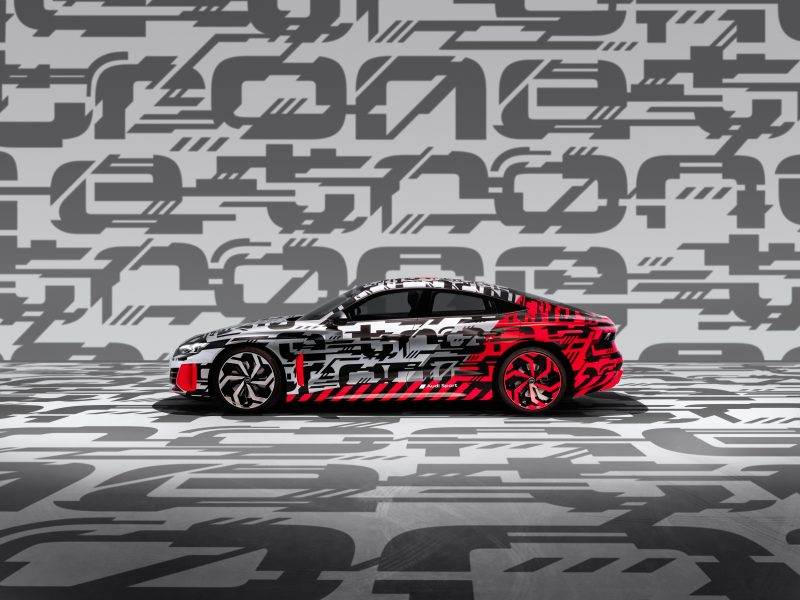
The Audi e-tron GT concept: Debut at the Los Angeles Auto Show 2018 on Wednesday 28, 2018
Auf der Los Angeles Motorshow 2018 gibt das Showcar Audi e-tron GT concept sein Debüt, ein hoch dynamisches Coupé mit flacher Bodengruppe. Die Technik dieses Automobils ist in Zusammenarbeit mit Porsche entstanden – Design und Charakter des e-tron GT concept bringen zugleich ein Maximum an unverwechselbarer Audi-DNA mit. Das Projekt wird bis Ende 2020 zur Serienreife entwickelt. Anfang 2021 sollen erste Auslieferungen an Kunden erfolgen.
Ein weiteres Gemeinschaftsprojekt der Entwicklungsabteilungen von Audi und Porsche ist die Premium-Architektur Elektrifizierung, kurz PPE. Sie wird die Basis für gleich mehrere Audi- Modellfamilien mit reinem E-Antrieb bilden, die vom B- bis zum D-Segment volumenstarke Segmente abdeckt.
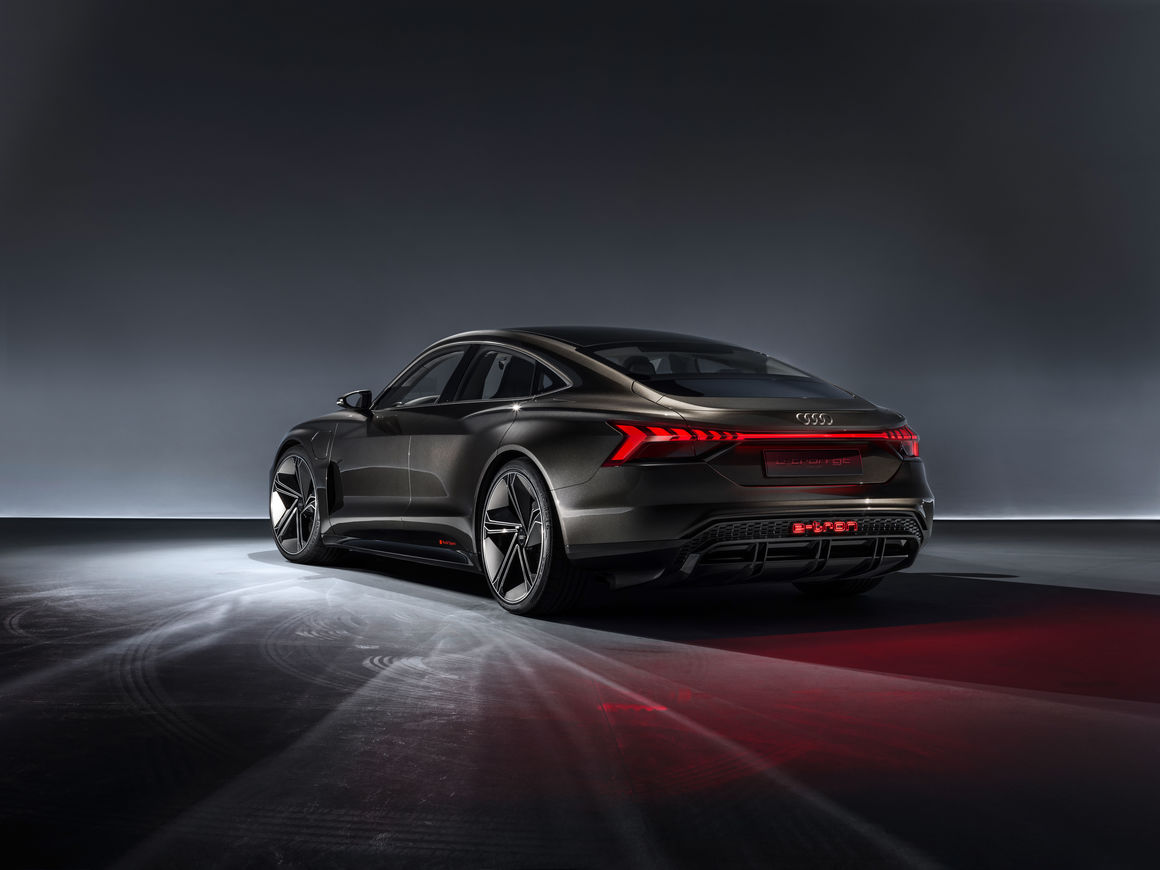
Audi e-tron, the third: The brand with the four rings is presenting one of the stars of the 2018 Auto Show in the movie capital Los Angeles. With the electric powered Audi e-tron GT concept a four-door coupé is making its debut as a show car. The volume-production counterpart is set to follow in around two years.
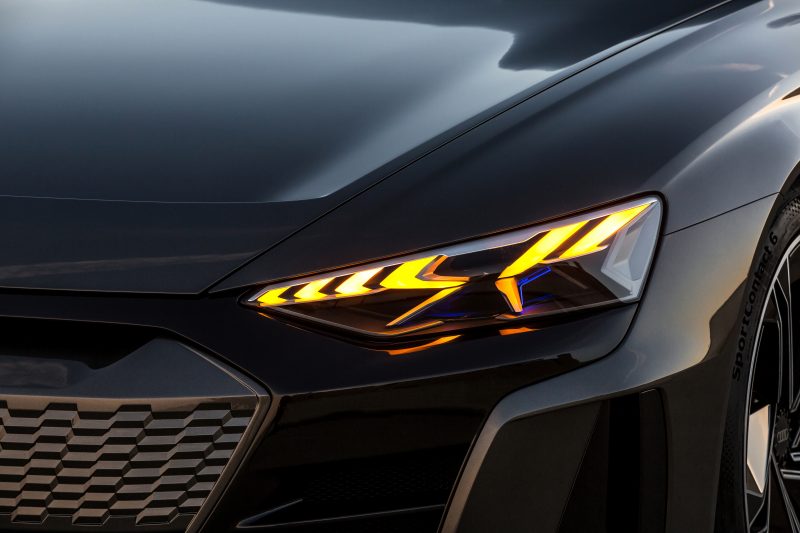
The Audi e-tron GT concept: Debut at the Los Angeles Auto Show 2018 on Wednesday 28, 2018
Inspiration drawn from the wind tunnel: design and body
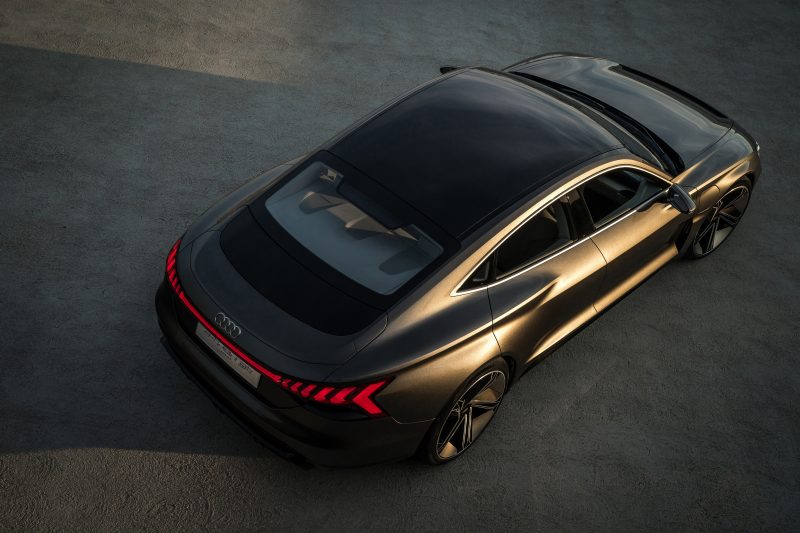
Static Photo
Colour: kinetic dust
Flat, wide and with a long wheelbase – those are the proportions of a classic Gran Turismo. And the Audi e-tron GT concept reflects these with its 4.96-meter (16.3 ft) length, 1.96-meter (6.4 ft) width and 1.38‑meter (4.5 ft) height. The lightweight body of the four-door coupé is manufactured using a multi-material construction. Here you have a roof section made from carbon along with numerous aluminum components and supporting elements made from high-strength steel. The technology for this automobile was developed in close collaboration with Porsche. Design and character are packed full of unmistakable Audi DNA.

Static Photo
Colour: kinetic dust
The gently sloping roofline of the e-tron GT concept that extends well into the rear echoes the Sportback layout that is the hallmark of the brand. This is however clearly taken forward into the future, pointing the way to the next evolutionary stage of the Audi design language. The cabin that tapers strongly toward the rear stands out compared with current Audi models. Wheel arches and shoulders are sculpted emphatically and, together with the flat floor that is unusual for an electric vehicle, visually underlines the low center of gravity and the dynamic potential of the Audi e-tron GT concept.

Static Photo
Colour: kinetic dust
The broad lines and the numerous functional elements of the body as well as the air vents of the wheel arches and the solid rear diffuser emphasize its origins in the wind tunnel. A low drag coefficient that reduces fuel consumption and the low uplift visually characterize the design.

Static Photo
Colour: kinetic dust
The sill area between the wheel arches has been drawn way outwards, creating a distinctive contrast with the cabin.The sill draws the eye to the underfloor area where the battery and thus the energy center of the Audi e-tron GT concept are located. The design of the wheels with their five twin spokes is also visibly aligned to their function. Their dynamic design provides optimum ventilation of the brake disks while also reducing drag. Shod with 285/30 size tires, the 22-inch wheels also make a clear statement when seen from the side.
The hallmark Audi Singleframe is located in the center of the front section. Compared with the two e-tron SUVs its architecture is much more horizontal. The top half comes with a cover painted in body color. Its surface structure is reminiscent of the typical honeycomb pattern of the grille on the Audi RS models – a visual signal which characterizes the Audi e-tron GT concept as a future product of Audi Sport GmbH.

Static Photo
Colour: kinetic dust
Together with the targeted airflow of the body, large air inlets in the front effectively cool the assemblies, battery and brakes. The hood with its airflow on the surface echoes the brand’s two latest show cars, the Aicon and the PB18 e-tron. It is designed in such a way that the airflow hugs the body, thus reducing undesired swirl.
The arrow-shaped front section also emphasizes the matrix LED headlights with laser high beam, underscoring the dynamic presence of the Audi e-tron GT concept even while stationary. As already seen with the brand’s current Visions vehicles, the light is also animated here and welcomes the driver with a short function sequence, the wave of light that extends horizontally: a new visual signature that is set to find its way into volume production in future.
A light strip runs across the entire width of the rear. This strip dissipates at the outer edges, in the actual lighting units, into individual wedge-shaped LED segments. This architecture links the e-tron GT with the volume-production SUV e-tron, making both instantly recognizable even in the dark as Audi electric automobiles.
The new exterior color kinetic dust – a warm, dark color akin to titanium – comes across as practical without being ‘technoid’ standoffish. Depending on the incidence and movement of the light, it provides significant contrast between the body surfaces. Matt, warm-tinted aluminum elements on the window slot trim and rims emphasize these effects even further.
Sustainable contemporary feel: the interior
Four doors, four seats with 2.90 meters (9.5 ft) wheelbase – in the interior the Audi e-tron GT concept provides a large dose of everyday usability, coupled with a superb quality feel. The functional center of the interior is located at the front left, visibly focused on the driver’s seat. The center console, the large touchscreen in the top section and the line from the door rail and cockpit frame the driver’s workplace, perfectly incorporate the driver ergonomically with the controls and the infotainment of the Audi e-tron GT. The center console and the freestanding instrument cluster seem to float. Light colors in the top section of the cockpit and the gradually darker gradation through to the floor area create the impression of clear width. Sport seats inspired by motor racing in both rows of seats provide optimum lateral support even while cornering at speed.

Interior
Both the screen of the central instrument and the touchscreen above the center console come with a black-panel look finish. They underscore the large, calm design of the interior with its predominantly horizontal basic architecture. Various layouts are available for the monitors to present the functions depending on the driver’s preference, including virtual instrument dials, easy-to-read navigation maps with information on the range, or various infotainment function menus. They are controlled via the touchscreen with tactile feedback.
With the concept car the designers have deliberately gone for the consistent use of sustainable materials – a clear statement of contemporary automotive design. Animal-based products are not used at all: the Audi e-tron GT concept comes with a vegan interior. Sophisticated, synthetic leather is used on the seats and other trim surfaces. Fabrics made from recycled fibers are used on the seat cushions as well as the armrests and on the center console. Microfiber material adorns the headlining and the trim of the window pillars. Even the deep-pile floor carpet is made from sustainable Econyl yarn, a recycled fiber made from used fishing nets.

Interior
With two luggage compartments, the Audi e-tron GT concept offers a great many options for a Gran Turismo. Here it makes full use of its concept advantage as an electric automobile with compact drive units. The rear with its large tailgate offers up to 450 liters (15.9 cu ft) of luggage capacity. Under the hood there is an extra 100 liters (3.5 cu ft) of capacity.
Performance and range: the drive
434 kilowatts (590 hp) system power – that is an impressive figure for the potential of the all-electric drive. Separate electric motors are fitted to the front and rear axles. In both cases these are permanently excited synchronous motors. They put down the torque onto the road via all four driven wheels – naturally the new Audi e-tron GT concept is also a genuine quattro. An electric quattro to be precise, since there is no mechanical link between the front and rear axle. The electronic control system coordinates the drive between the axles as well as between left and right wheels. That means optimum traction and just the desired amount of slip.

Audi e-tron GT concept
In future, the vehicle should accelerate from 0 to 100 km/h (0-62.1 mph) in around 3.5 seconds before going on to 200 km/h (124.3 mph) in just over 12 seconds. The top speed is regulated at 240 km/h (149.1 mph) to maximize the range. One feature that not all the competition can match is the option of fully utilizing the drive’s acceleration potential several times in succession. While elsewhere the drive is switched to overdrive for thermal considerations, the Audi e-tron GT concept can provide the driver with the full potential of both motors and the battery thanks to its sophisticated cooling strategy.
The range of the concept car will be over 400 kilometers (248.5 mi), determined according to the new WLTP standard. The required drive energy comes from a lithium-ion battery with an energy content of more than 90 kWh, which takes up the entire underfloor area between the front and rear axle with its flat design. The decisive advantage of this design is the car’s extremely low center of gravity – comparable with that of the Audi R8 – which in turn decisively benefits dynamic handling. All-wheel steering translates this into a perfect synthesis of sports car-like agility and precision, augmented by superb directional stability.

Audi e-tron GT concept
The recuperation system increases the range by up to 30 percent on Audi electric vehicles – this is essential even with such a sporty car as the Audi e-tron GT concept. The recuperation involves both the two electric motors and the electrohydraulically integrated brake control system. Different recuperation modes are combined: manual coasting recuperation using the shift paddles, automatic coasting recuperation via the predictive efficiency assist, and brake recuperation with smooth transition between electric and hydraulic deceleration. Up to 0.3 g, the Audi e-tron GT concept recuperates energy solely via the electric motors, without using the conventional brake – that covers over 90% of all decelerations. As a result, energy is fed back to the battery in practically all normal braking maneuvers. The wheel brakes are involved only when the driver decelerates by more than 0.3 g using the brake pedal. The Audi e-tron GT concept features high-performance ceramic disks which also operate with multiple extreme decelerations without compromising braking performance.
Reduces charging times: 800-volt charging system
The battery in the Audi e-tron GT concept can be charged in several ways: using a cable which is connected behind the flap in the left front wing, or by means of contactless induction with Audi Wireless Charging. Here a charging pad with integral coil is installed permanently on the floor where the car is to be parked, and connected to the power supply. The alternating magnetic field induces an alternating voltage in the secondary coil fitted in the floor of the car, across the air gap. With a charging output of 11 kW the Audi e-tron GT concept can be fully charged conveniently overnight.
Wired charging is much faster as the four-door coupé is fitted with an 800-volt system. This substantially reduces charging times compared with conventional systems that are currently in use. Thus it takes around 20 minutes to recharge the battery to 80 percent of its capacity, once again providing a range of more than 320 kilometers (198.8 mi)(WLTP). The e-tron GT concept can, however, also be recharged at charging points with lower voltages, providing the driver with access to the entire charging network.
Audi: electric offensive continues
The brand with the four rings launched its electric offensive with the world premiere of the all-electric SUV Audi e-tron in September 2018. By 2025 Audi will offer twelve automobiles with all-electric drive in the most important markets worldwide and achieve roughly one-third of its sales with electrified models. The SUVs within this portfolio include the Audi e-tron and the Audi e-tron Sportback due to make its debut in 2019. In addition, there will be a range of models with classic body layout such as Avant and Sportback. The range will cover every relevant market segment from the compact to the full-size class.
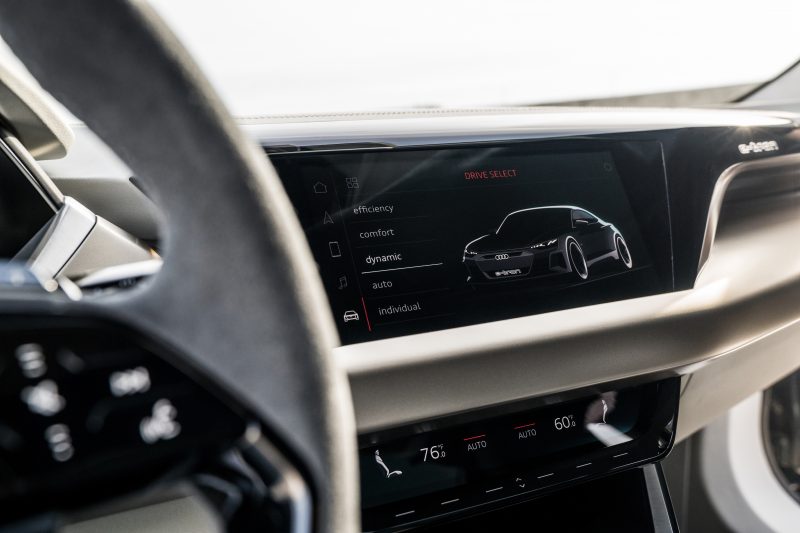
Detail
The Audi e-tron GT concept show car, a highly dynamic coupé with a low floor, is debuting at the Los Angeles Auto Show 2018. The technology in this automobile was developed in collaboration with Porsche; the design and character of the e-tron GT concept are packed full of unmistakable Audi DNA. The project will be developed into volume-production models by the end of 2020. Initial deliveries will be made to customers in early 2021.
Another joint project of the development departments at Audi and Porsche is the Premium Platform Electric (PPE). It will be the foundation for multiple Audi model families with all-electric drive covering the high-volume B through D segments.
-Ends-
Images and Video Audi AG

